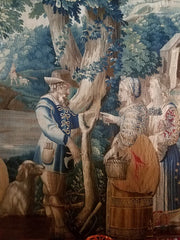
Rootstock
Rootstock

Grafting over a fruit tree in France 1600's
The lower portion of the a fruit tree is called the rootstock. This is the portion of the tree that has been grafted over to a specific variety. Different rootstocks provide opportunities for everyone to enjoy the thrill of growing your own fruit. Lastly, pruning has a great impact on size, if you need to maintain a certain height then also prune in the summer.
Note: Mature tree size is determined by the rootstock in combination with the vigor of the variety. For example, a Northern Spy or Gravenstein on a semi-dwarf rootstock will be larger than a Jonathan or Idared on the same rootstock.
Apple Rootstock
MM111 (Semidwarf) Produces a tree 70-80% of standard size. Growth tends to be upright with wide crotch angles. Well anchored, resistant to drought and high soil temperatures. Excellent semi dwarf rootstock for heavy soils. Resistant to wooly aphids. Disadvantage is burr knotting. Bears fruit in 2 to 4 years and grows to 10 to 16 ft depending on variety. Summer prune to 8ft. if smaller tree is desired.
Pear Rootstock
Standard Produces a strong well anchored tree. Trees are vigorous and tolerant of drought and wet soils. Begins to bear fruit between 3-8 years of age and grows to 15-20 feet.
OHxF 333 (Old Home and Farmingdale) Produces a tree 75% of standard size. Resistant to fire blight and pear decline. Does not sucker and developes hardy well anchored tree. Tolerates a broad range of soils. Bears fruit in 3-4 years and grows to 12-16 feet.
Stone Fruit Rootstock
Lovell Produces a strong well anchored tree with resistance to bacterial canker. Tolerates cold and wet soils. Susceptible to nematodes in sandy soil. Bears fruit in 2-3 years and grows to 12-18 feet.
Mariana Produces a shallow rooted tree allowing greater tolerance to wet soils. Resistant to oak root fungus, some nematodes and brown line. Slightly dwarfing for plums and apricots. Bears fruit in 2-3 years and grows to 12 – 16 feet.
Mazzard Cherry rootstock that produces a large tree well anchored that tolerates heavy soil. Resistant to oak root fungus and root knot nematodes. Bears fruit in 2-5 years and grows to 20-35 feet.
Mahaleb Cherry rootstock that produces a standard size tree for sour cherries and slightly dwarfing for sweet cherries. Prefers well drained soils. Resistant to crown gall, bacterial canker, and some nematodes. Hardy to zone 4. Bears fruit in 2-4 years and grows to 20-30 feet.
Colt Cherry rootstock that produces wide branched angles on a well anchored tree. Tree is 70-80% of standard. Resistance to bacterial canker and crown gall. Hardy to -10 F. Bears fruit in 2-4 years and grows 15-20 feet.
G.M. 61/1 Cherry rootstock that produces a open, moderately vigorous, frost resistant, few suckers and thrives in heavier soil. Bears fruit in 2-4 years and grows to 8-12 feet.
Myrobalan Produces a tree with great anchorage and tolerant of wet soils. Susceptible to oak root fungus and nematodes. Bears fruit in 2-3 years and grows to 12-16 feet.
Nemaguard Produces a vigorous tree in well drained soils. Susceptible to wet feet. Redundant phrase, but needs to be said, nematode resistant. Bears fruit in 2-3 years and grows to 12-18 feet.
Citation Produces a tree 50-65% of standard in peaches and 75% of standard in apricots and plums. Strong well anchored. Resistant to nematodes, tolerant of wet soils, no suckers, and cold tolerant. (zone 4). Bears fruit in 2-3 years and grows to 12-16 feet.
Nut Rootstock
Almond Resistant to bacterial canker and nematodes. Bears fruit in 2-4 years and grows to 10-14 feet.
Walnut Bears fruit in 4-8 years and grows to 18-30 feet


